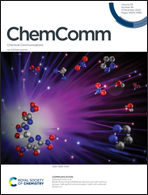Recent advancements in the use of Bobbitt's salt and 4-acetamidoTEMPO
Abstract
Recent advances in synthetic methodologies for selective, oxidative transformations using Bobbitt's salt (4-acetamido-2,2,6,6-tetramethyl-1-oxopiperidinium tetrafluoroborate, 1) and its stable organic nitroxide counterpart ACT (4-acetamidoTEMPO, 4-acetamido-2,2,6,6-tetramethylpiperidine-1-oxyl, 2) have led to increased applications across a broad array of disciplines. Current applications and mechanistic understanding of these metal-free, environmentally benign, and easily accessible organic oxidants now span well-beyond the seminal use of 1 and 2 in selective alcohol oxidations. New synthetic methodologies for the oxidation of alcohols, ethers, amines, thiols, C–H bonds and other functional groups with 1 and 2 along with the field's current mechanistic understandings of these processes are presented alongside our contributions in this area. Exciting new areas harnessing the unique properties of these oxidants include: applications to drug discovery and natural product total synthesis, the development of new electrocatalytic methods for depolymerization of lignin and modification of other biopolymers, in vitro and in vivo nucleoside modifications, applications in supramolecular catalysis, the synthesis of new polymers and materials, enhancements in the design of organic redox flow batteries, uses in organic fuel cells, applications and advancements in energy storage, the development of electrochemical sensors, and the production of renewable fuels.

- This article is part of the themed collections: 2023 Emerging Investigators and Chemical Communications HOT Articles 2023


 Please wait while we load your content...
Please wait while we load your content...